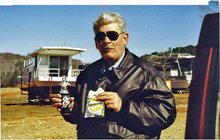In 1991, the ferry was purchased from the Howards by the Fayette, Jessamine, and Madison County governments and, today, jointly run it under the direction of an appointed board. It operates daily from 6 AM to 8PM on weekdays, and 8 AM to 8 PM on weekends. It is closed during times of high water and necessary maintenance or repair. It is the oldest continuously operating ferry service in the United States. The current vessel, named the "John Craig" replaced the previous vessel in 1996 after it sustained heavy damage after sinking under the weight of a heavy snowfall and then as a result of salvage efforts. In 2000, the ferry was lengthened by ten feet allowing it to increase its capacity to three cars. The Kentucky Transportation Cabinet funds the ferry as a free service; it is part of S.R. 169. On average, the ferry transports 250 cars a day.
In the late 1800's and early 1900's, the ferry served a bustling society. The thriving industrial community of Valley View included blacksmith shops, general stores, sawmills, public school, railroad depot, telegraph office, post office, and weekly newspaper. The Southern Lumber Companyoperated a steam-powered three-story band-sawmill complete with its own electric light plant. During the 1920's, after the decrease in logging, and then the Depression of the 1930's, the lumber and railroad businesses failed. The peaceful hamlet became content with a slower pace. Today, the piers of the RIN & B Railroads (Richmond, Nicholasville, Irvine, and Beattyville), fondly referred to as the "Riney - B" by those who remember it, maintain a faithful sentinel over the pleasant valley, a reminder of a chapter in Kentucky history.

